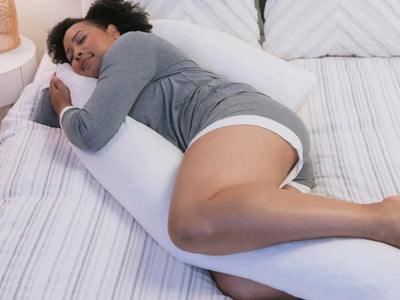
Related Product
How to Use a Pregnancy Body Pillow
Share
If you’re pregnant, finding a comfortable position to rest in can become challenging the more your abdomen grows. Fortunately, pregnancy body pillows exist to help you get the rest you deserve as an expecting mother. Don’t worry if you’ve never used a body pillow before.
In this guide, we’ll cover how to use a body pillow while pregnant, selecting the right pregnancy pillow for you, the benefits of using one, and other ways to alleviate the pains of motherhood. Keep reading to learn everything you need to know about pregnancy body pillows, or use the links below to skip to the sections that interest you.
- What is a Body Pillow?
- 4 Steps to Use a Body Pillow While Pregnant
- Why Should You Use a Body Pillow While Pregnant?
- Alternative Sleeping Positions For Pregnant Women
- Final Notes
What is a Body Pillow?
Unlike a traditional pillow, which standard size is 20” x 26” inches, a body pillow is much longer, usually 20’’ by 54” inches, and will typically reach the full length of an adult’s body.
There are several ways to use a body pillow, including to prop yourself upright, place it under your legs for elevation, or sleep comfortably on your side. A body pillow is often ideal for pregnant women since it can alleviate the aches and discomfort of motherhood.
In addition to minimizing the adverse symptoms of pregnancy, a body pillow can also be used to make recovering from surgery easier, improve sleep apnea, or provide support for those suffering from back pain or arthritis.
4 Steps to Use a Body Pillow While Pregnant
Body pillows for pregnant moms are a great investment, but they can be intimidating for many because of their unique look. If you’re unsure about how to use a body pillow while pregnant and don’t know where to place your arms, legs, and head, we’ve broken down the process into four simple steps.

1. Choose a pillow shape
Body pillows come in various shapes and sizes to keep you comfortable through different activities, such as laying down sideways. Using the correct type of body pillow shape is essential to ensuring your head, neck, back, and legs have ample support as your baby develops. A few of the most popular body pillow shapes for pregnancy include:
- C-shaped body pillow: Body pillows that are C-shaped will relieve tension from your back and provide support for your head, neck, and pelvic area. C-shaped body pillows are most commonly used by side sleepers. However, if you frequently switch sides during the night, you’ll have to adjust the pillow as well.
- J-shaped body pillow: As the name implies, J-shaped body pillows are designed in the shape of a J and are most often used by side sleepers as well. J-shaped pillows can help support your back, head, and neck while taking up less space than C-shaped pillows.
- U-shaped body pillow: U-shape body pillows will make side-sleeping easier, whether you sleep on your right or left, as the unique U-shape cradles your body on each side. Besides providing head-to-toe support, a U-shape pillow will also prevent you from jostling around at night. However, these body pillows are typically larger than C- and J- shape pillows, so they can take up a lot of room on your bed.
If you’re looking for a body pillow that can provide your growing belly and changing body with plenty of support without sacrificing the space on your bed, look no further than MedCline’s body pillow for pregnancy. Our Therapeutic Body Pillow helps you achieve a blissful sleep by encouraging healthy spine alignment and providing optimal support for your neck, body, and hips.

2. Place the pillow between your arms and legs
Once you’ve selected the style of pillow you like and feel most comfortable with, it’s time to put it to work.
Grab your pillow and press the longer side of it against the front of your body, placing the lower half between your legs and the upper portion of the pillow between your arms. Ensure that the pillow carries the weight of your belly. Pair key pregnancy sleeping positions with a body pillow to relieve tension in your joints.
Keep in mind that body pillow placement may vary slightly depending on its shape.

3. Wrap the pillow around your back
You’ll also want to wrap the pillow around your neck to support your head and neck, allowing it to elevate your head slightly.
Propping your head while you sleep has many benefits, especially when you’re pregnant. This includes minimizing symptoms of acid reflux and heartburn during pregnancy.

4. Make sure the pillow is firm
Ideally, you want the pregnancy body pillow you use to be firm enough to support you and your growing baby. However, just like body pillows come in all shapes and sizes, the materials used for the fill will also vary. Take a look at the most common types of fill below:
- Memory foam: Pillows made with memory foam often conform to the user’s body while retaining their shape after use.
- Down feather: Down pillows use waterfowl (i.e., duck, goose, or swan) plumage and can be very soft, requiring the pillow to be fluffed often.
- Latex: Pillows filled with latex offer a similar level of support as memory foam.
- Polyester: Polyester is an inexpensive fill material that’s lightweight and not breathable, so it might not be the best option during warmer months or if you get hot easily. It’s also not malleable and can clump easily.
The materials a body pillow for pregnant ladies is made out of ultimately depends on the manufacturer. At MedCline, we use adjustable shredded memory foam stuffing in our Therapeutic Body Pillow, allowing you to effortlessly get the support you need.
Why Should You Use a Body Pillow While Pregnant?
Pregnancy can change your life in all kinds of ways—from developing varicose veins to swollen feet. A body pillow can support you as your body experiences the changes of motherhood. Often, fatigue is one of the most common pregnancy complaints, which is why it’s essential to get plenty of rest.
However, as the nights go on, it can be difficult to find a comfortable sleeping position. Not only can this affect your mood, but it can also affect the physical well-being of you and your baby. In fact, according to Johns Hopkins Medicine, not getting enough sleep while pregnant can lead to pregnancy complications, including high blood pressure and gestational diabetes. It may also increase the likelihood of long labor or cesarean section.
A pregnancy body pillow can provide your body with the support it needs to get a good night’s rest, relieving pressure from the back, hips, knees, and shoulders. This will give your joints a much-needed break, allowing them to recover and minimize growing pregnancy pains. Many expecting mothers also experience heartburn during their third trimester. You can reduce heartburn symptoms by using a pregnancy sleeping pillow to elevate your head as you sleep.
Plus, you’ll be able to support your head, legs, and growing belly without the need for extra pillows. This investment also won’t go to waste even after your baby is born. Body pillows can be used post-pregnancy to support you while nursing.

Alternative Sleeping Positions For Pregnant Women
If a pregnancy body pillow isn’t the right fit for you or if you’re not ready to learn how to use a body pillow while pregnant, how should you sleep during pregnancy? In this section, we’ll discuss the best and worst sleeping positions for pregnant women.
What is the best way to sleep while pregnant?
If you’re pregnant, it’s best to avoid sleeping on your back or stomach—this can be difficult if you’re used to sleeping in those positions. However, sleeping on your back or stomach can become excruciatingly uncomfortable as time goes on, putting unnecessary strain on your body, and negatively impacting the health of your baby.
- Effects of sleeping on your back: While sleeping on your back during the early days of your pregnancy may not be unpleasant, it can take a toll on your body and cause health issues, including back pain, hemorrhoids, low blood pressure, and sleep apnea as your midsection grows along with your baby. It can also restrict circulation to your baby and heart.
- Effects of sleeping on your stomach: As you get farther into your pregnancy, sleeping on your stomach may be challenging, depending on the changes in your body.

What is the best way to sleep while pregnant?
According to the American Pregnancy Association, the best way to sleep while pregnant is on your side. Not only can sleeping on your side help you sleep better during your pregnancy, but it can also provide several health benefits, such as:
- Improving circulation throughout your body
- Removing pressure from vital internal organs and veins
- Reducing swelling
Final Notes
If you find yourself tossing and turning and unable to sleep comfortably at night, or you can’t find relief from common pregnancy pains, a body pillow may be the solution you’re looking for. While it may seem like a nonessential luxury, it can provide several benefits, like alleviating heartburn and improve how you sleep, that’ll make your pregnancy smoother and more enjoyable.
Pregnancy comes with many ups and downs, but we believe pregnancy should be as comfortable and pain-free as possible. Our Therapeutic Body Pillow offers full-body support for left- and right-side sleepers, helping your neck, hips, and body remain properly aligned as you sleep.
Achieving a good night’s rest isn’t always easy, so check out our tips for better sleep for additional assistance.



